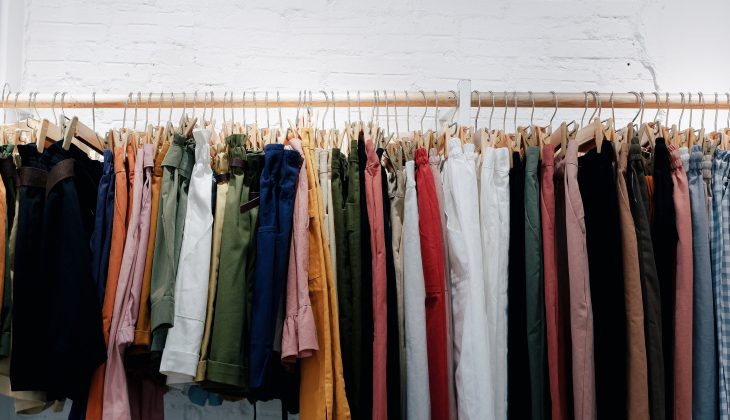Fast fashion is a major subject, covering everything from waste, the impact of the fast fashion industry on climate change, to workers’ rights. The fast fashion industry is one of the most profitable industries in the world and at the same time the one that is most environmentally destructive. We all wear clothes, so we all have a role to play in moving towards a better and greener fashion industry.
Here are 10 facts to bear in mind when it comes to fast fashion and making more ethical clothing choices.
1. Fast fashion is harmful to our planet
The fast fashion industry has a negative impact on our environment. Clothing is often made with toxic dyes and uses large quantities of water. These toxic chemicals often find their way into areas surrounding factories, damaging the environment and threatening the health of nearby communities, as well as wildlife and ecosystems.
Clothes from these industries release microplastics into our oceans. Every time (cheap, synthetic) materials such as polyester or nylon are washed, tiny plastic particles are released, which can end up in bodies of water, affecting wildlife and drinking water.
2. Fast fashion brands contribute to climate change
The global fashion industry released around 2.1 billion tonnes of greenhouse gases in 2018, accounting for 4% of the world total. This is down to the way that companies source their materials. The clothes are often made far from where they are sold. Making a single garment can involve a great deal of travelling back and forth between different factories and production lines.
3. Fast fashion brands and their workforce
Fast fashion clothing is often manufactured in countries with little protection for the workforce and where workers are paid very low wages (around €2 a day, according to the Clean Clothes campaign). Workers’ health is also at risk because toxic chemicals and dyes are not disposed of safely.
4. Improving factory conditions would not increase the cost of clothes
According to the Clean Clothes campaign, clothing workers’ wages are rarely more than 3% of the price paid in the shop. Increasing wages would not affect the price of individual garments, but would simply reduce the company’s profit (which is about 59% of the retail price of the clothes).
5. Sweatshops are not necessary
Some fashion enterprises justify their treatment of workers by claiming that they provide work in places where employment opportunities are scarce. However, this does not justify the exploitation and mistreatment of workers. The workplaces are overcrowded, with poor and unacceptable or illegal working conditions. Clothing companies can improve their standards. If more companies were to put workers’ rights and environmental protection above profits, factories would be forced to adopt higher standards.
6. Fast fashion companies put their profit first
Fast fashion companies are interested in making profits, not helping local communities. If they did, the workers would be paid a living wage and the chemicals from the waste water would not flow into the surrounding streets and water courses. Often, as wages rise or workers’ rights improve, brands move to other countries where they can continue to produce cheaply.
7. It is not sustainable even if the label says so
More and more fashion brands are exhibiting sustainable practice – a sign that fashion activists’ campaigns are having an impact. However, many fast fashion brands use this as a marketing ploy to sell more clothes. This is called greenwashing – when a company claims to be more sustainable than it really is.
It is worth exploring why brands are highlighting particular sustainable features instead of making their systems, practices and everything they sell more sustainable.
8. Discarding fast fashion clothing is not an answer
In an effort to live more frugally and to use fewer items, many people try to adopt a minimalist approach, which involves getting rid of anything that is not really needed. They also create a capsule wardrobe, which means reducing the number of clothes in the wardrobe down to a handful of essentials. The journey towards a capsule wardrobe often starts with chucking out everything you do not want to keep; however, this is not exactly a sustainable approach. Instead, it is better to find creative uses for the things in your wardrobe. Try new things: use accessories, make old clothes trendy, try dyeing, tying or bleaching. Old T-shirts can become dust cloths.
9. Donating or selling clothes is not always sustainable
Donating or selling clothes is better than putting them in the bin, but this too has its complications. First of all, not everything that is donated is suitable, which means that the charity shop or clothing bank will still have to throw the clothes away. Clothes are also sent abroad to be sold in other countries, but can also end up in landfills there. According to the Ellen MacArthur Foundation, less than 1% of the world’s clothing is made into new garments, which means that the recycled garments are still scrapped, landfilled or burned.
People have also started to make money from second-hand clothes. They buy second-hand or vintage clothes at a low price but resell them at a higher price.
Donating old clothes is still an important part of creating a more sustainable fashion industry, but it is worth remembering that it is not always as straightforward as it seems.
10. The best way to be sustainable is to buy less
According to EPA (EPA) around 63,000 tonnes of clothing and other textiles are collected as municipal waste in Ireland every year and processed in waste treatment plants or landfills. Buying second-hand or choosing sustainable materials is great. But the best thing you can do is to buy less and consume less. This means less waste.
We need to move away from a consumer culture. Before throwing clothes away, you should consider whether they could be: repaired, donated, sold or reused.
Source: https://spunout.ie/life/climate/10-fast-fashion-facts
This article was edited by Maria Schotter, a Content creation and Collaborative Relations team member at the youth information portal Teeviit.
This article is published on the youth information portal Teeviit in 2022.







